There is a very simple method for trading coins that ensures 'everlasting profit'.
'Lazy person's three-board axe': I turned 8000 USDT into 120,000 USDT, with a profit rate of nearly 85%, without a single blow-up.
A method I've personally tested: my trading method is very simple and practical. Within a year, I traded up to a seven-figure amount, only focusing on one pattern, entering only when opportunities arise, and not trading without a pattern, maintaining over 90% win rate for five years!
This method is still in use by me (suitable for everyone) and is very stable. In later trading processes, it can help you earn an additional 3 to 10 points of profit daily.
The core method consists of three steps:
① Look at trend funds, not candlestick charts.
Every morning, I only do one thing—look at the capital flow of mainstream coins: who is entering? Who is fleeing? Who is playing dead?
A drop in coin price is not scary; what’s scary is when the core addresses lose confidence. As long as 'smart money' is still around, I dare to act.
② Split position operations, never gamble on life trades.
I am used to splitting an opportunity into three positions: the first is a small test, the second is an add-on, and the third is to lock in profits.
Set a maximum stop-loss of 2%, add positions if there is direction, and exit immediately if wrong, without dragging your feet.
③ Do the opposite trades that others dare not do.
Market sentiment is often most fearful when the main force enters the market.
The more it drops, the more people panic and shout 'it's over', the tighter I watch.
While others are cutting losses, I take the first bite; while others want to catch the bottom, I've already taken profits and left the market.
Maintain rhythm, reject illusions, and respect losses.
It's okay to lose; start using the 'silliest method' now.
Only take certain actions, only invest in what you understand.
A correct method + stable execution + a good team to guide you.
Much better than busily working alone!
Those who want to turn around and understand will naturally find me.
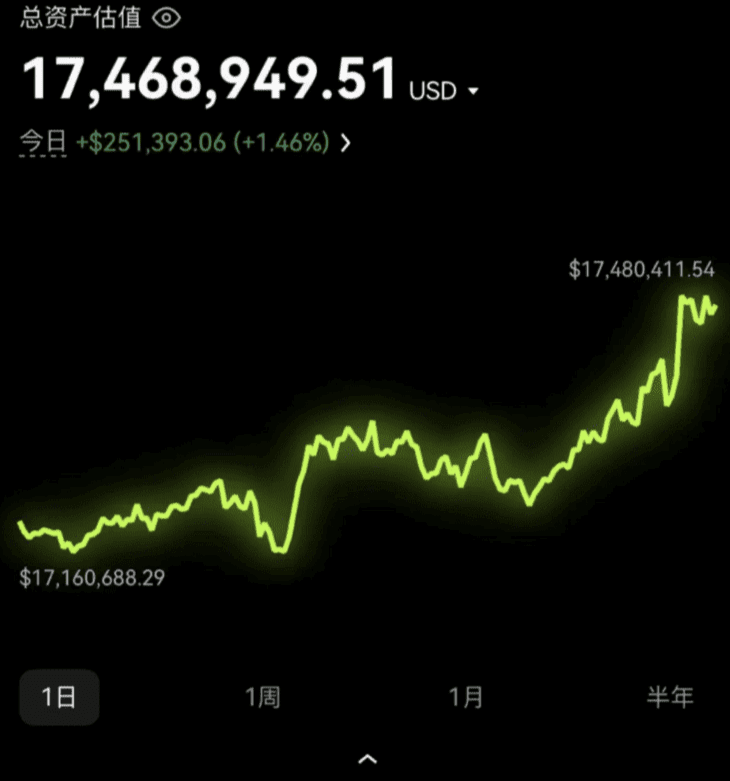
In the crypto world, achieving financial freedom and transitioning classes, I have summarized ten trading skills. Understand one of them, and you too can achieve stable profits; it's worth learning repeatedly.
1. Two-way trading: suitable for bull and bear markets. Two-way trading is currently the most common trading method on the GGtrade platform, which allows for operations according to the movements of the coin market. You can buy up or down, and as the year-end approaches, the GGtrade platform has also launched a series of promotional benefits, such as a 20% increase in investment returns, which is a significant boon for investors.
2. Coin hoarding method: suitable for bull and bear markets. The coin hoarding method is the simplest yet the most challenging way to play. It is simple because after buying a certain coin or several coins, you just hold them for more than six months or a year without operating. Generally, the minimum return can be tenfold. However, novices often see high returns or encounter price halving, leading them to change coins or exit. Many find it challenging to stick to not operating for a month, let alone a year. So this is actually quite difficult.
3. Bull market chasing method: suitable only for bull markets. Use a portion of spare funds, preferably no more than one-fifth of your capital. This method is suitable for coins with a market value between 20 and 100, as it won't get stuck for too long. For example, if you buy the first altcoin and wait for it to rise by 50% or more, you can then swap it for the next coin that has dropped sharply, and continue this cycle. If your first altcoin is stuck, just wait; the bull market will definitely get you out. The premise is that the coin should not be too risky; this method is also difficult to control, and newcomers need to be cautious.
4. Hourglass switch method: suitable for bull markets. In a bull market, basically, any coin you buy will increase. Funds act like a giant hourglass slowly seeping into every coin, starting from large coins. There’s a clear pattern for price increases: leading coins like BTC, ETH, DASH, and ETC rise first, followed by mainstream coins like LTC, XMR, EOS, NEO, QTUM, etc. Then, the coins that haven't increased will rise in unison, followed by various small coins taking turns to rise. But if Bitcoin rises, you should choose the next level of coins that haven't increased yet and start building positions.
5. Pyramid Bottom-Fishing Method: suitable for predicting significant crashes. The bottom-fishing method: place orders to buy one-tenth of the position at 80% of the coin price, one-fifth of the position at 70%, one-third at 60%, and one-fourth at 50%.
6. Moving Average Method: Understand some basics of candlestick patterns. Set indicator parameters for MA5, MA10, MA20, MA30, MA60, and select a daily timeframe. If the current price is above MA5 and MA10, hold on. If MA5 falls below MA10, sell the coin. If MA5 rises above MA10, buy to establish a position.
7. Violent coin hoarding: only do coins you are familiar with, suitable only for long-term quality coins. If you have liquid funds, and a certain coin is priced at $8, then place an order at $7 to buy. Once the purchase is successful, place an order to sell at $8.8. The profit is for hoarding coins. Withdraw the liquid funds and wait for the next opportunity. Dynamically adjust based on the current price. If there are three such opportunities in a month, you can hoard quite a bit of coins. The formula is: buying price equals current price multiplied by 90%, selling price equals current price multiplied by 110%!
8. AISO violent compound interest method: continuously participate in ICOs; when new coins increase by 3-5 times, take back the principal and invest in the next ICO, letting the profits continue to compound.
9. Cycle band trading method: find coins like ETC that are undervalued; increase positions when the coin price keeps falling, and continue to add when it falls further, then wait until you profit to sell, continuously cycling.
10. Violent small coin play: if you have 10,000 yuan, divide it into ten parts, buying ten different types of small coins, ideally priced below 3 yuan; after buying, do not intervene. If it doesn’t triple or five times, don’t sell; if it gets stuck, don’t sell; just hold onto it as a long-term investment. If a certain coin triples, take back your principal of 1,000 yuan and invest in the next small coin. The compound interest returns can be quite impressive!
After years of navigating the cryptocurrency market, I have summarized a set of effective investment strategies. These rules not only apply to beginners but also help experienced traders stay clear-headed in complex market environments, achieving stable returns. Here are eight iron rules from veteran traders in the crypto world:
1. Capital management: act within your means and diversify risks.
Concentrate on holding one coin within 100,000: when funds are limited, focus on holding one potential coin, deeply researching its fundamentals and technicals.
200,000 to 300,000, playing with two coins: when funds are slightly more, they can be spread over two coins to reduce the risk of a single coin.
Within 500,000, three to four coins are enough: when funds increase further, hold a maximum of three to four coins to avoid excessive diversification.
No matter how much capital you have, it should not exceed five coins: regardless of capital size, the number of coins held should not be too many to avoid management difficulties.
Concentrate firepower in a bull market, and use light positions in a bear market: in a bull market, concentrate funds on the most promising coins; in a downturn, take lighter positions to minimize losses, and be able to withdraw quickly even if you incur losses.
2. The trend is king: follow the market, do not go against the trend.
Read news, learn techniques: understand market dynamics and technical indicators to improve investment win rates.
A rebound after a drop is often a trap, while a correction after a rise may be a pitfall: do not blindly catch the bottom or chase highs; operate according to the trend.
Do not guess the main force's intentions: the actions of the market's main players are hard to predict; focus on your investment strategy.
3. Only act when the market is lively, and respond flexibly.
Act when the market is active: when market heat is high, investors are more optimistic and can seize opportunities more easily.
Operate flexibly, do not be rigid: adjust strategies in a timely manner based on market changes; do not stick to old patterns.
4. Stop-loss and take-profit: protect capital and lock in profits.
Set a fixed stop-loss point: cut losses in a timely manner to avoid greater losses.
Gradually increase the selling price: when in profit, gradually raise the selling price to ensure profits are not lost.
5. Buy quickly and sell decisively: make prompt decisions to avoid hesitation.
Buy quickly: decisively buy when you discover an opportunity to avoid missing out.
Sell decisively: sell decisively when reaching expected targets or when the market turns, to avoid losses caused by greed.
6. Think carefully before adding positions.
Ask yourself: Before adding a position, consider whether you are willing to invest new funds under the current circumstances. If the answer is yes, then consider adding a position.
7. Focus on long-term, with short-term as a supplement.
Avoid frequent short-term speculation: short-term operations can easily lead to losing direction and affect your mindset.
Follow the trend: large investments should follow the market trend and hold potential coins for the long term.
8. Do not blindly catch the bottom; treat the market rationally.
A large drop does not mean you can catch the bottom: a significant market drop does not necessarily indicate that the bottom has been reached; blind bottom-fishing may lead to continued losses.
Few people make money in the market: only a small number of people can truly make money in the market, so stay rational and do not blindly follow the crowd.
Advice:
A bull market is not only a test of price fluctuations but also a test of investor psychology. Staying calm and following the above iron rules will allow you to progress steadily through bull and bear markets, ultimately achieving wealth growth.
Let me share a set of my own practical strategies that have achieved an average win rate of 80%. This is a considerable achievement in the crypto trading circle.
Enough talk; let's get straight to the point!
In two years, I turned 3,000 yuan into over 10 million, relying on this set of (5-0 trading patterns). If you read this article carefully, you will benefit for a lifetime!
The 5-0 trading pattern is a harmonic trading model used by technical analysts to identify potential reversal points in the market. This pattern is characterized by a unique five-wave structure, providing a systematic approach for predicting and capturing market direction shifts.
By combining Fibonacci retracement and extension levels, the 5-0 trading pattern can accurately identify potential reversal areas. This model is particularly a high-probability trading tool for traders looking to enter at reversal trades.
Analysis of the structure of the 5-0 pattern.
The 5-0 trading pattern is essentially a technical chart pattern composed of five consecutive price fluctuations (also known as 'legs'), labeled as XA, AB, BC, CD, and DE. This pattern typically appears after a long-term trend, indicating that the original trend may reverse or pause.
Each wave follows specific Fibonacci retracement and extension ratios, making the 5-0 pattern a logically clear and structurally rigorous tool that can reveal reversal areas that ordinary technical indicators may miss.
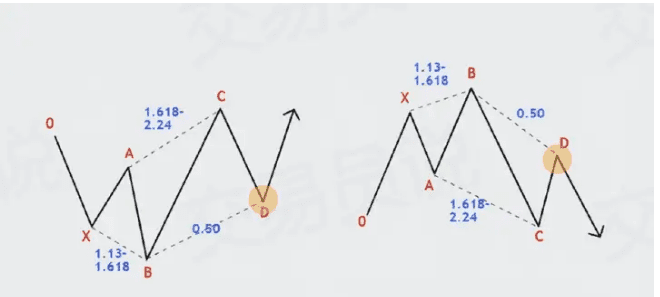
Here are detailed explanations of each price structure:
● 0X: Initial trend.
● XA: The retracement of the 0X wave, usually near the 38.2% to 50% Fibonacci retracement level.
● AB: The extension wave that exceeds the XA wave, usually reaching the 113% to 161.8% Fibonacci retracement level of the XA wave.
● BC: The extension wave that exceeds the AB wave, usually reaching the 161.8% to 224% Fibonacci retracement level of the AB wave.
● CD: The final wave that completes the pattern, usually corresponding to the 50% Fibonacci retracement level of the BC wave.
How to draw the 5-0 trading pattern.
Drawing the 5-0 trading pattern requires a systematic approach, whether manually drawing or using automated tools.
To manually draw the 5-0 trading pattern, traders must follow these steps:
1. Identify the initial trend (0X): first, observe a strong trend in the market that will serve as the foundation for the entire pattern, forming the XA wave.

2. Measure the retracement of the XA wave: use the Fibonacci retracement tool to measure the retracement of the XA wave, ensuring it is within the 38.2% to 50% range of the XA wave. This step is used to confirm the first adjustment phase of the pattern.
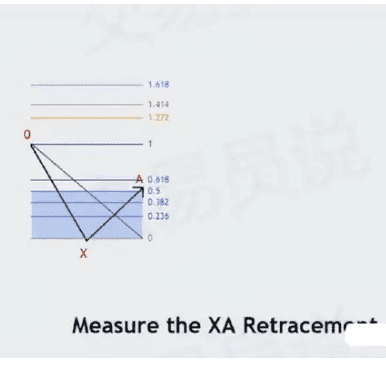
3. Find the extension of the AB wave: identify the AB wave, which must exceed the high/low of the XA wave. Confirm that the amplitude of the AB wave exceeds 100% of the XA wave using the Fibonacci extension tool; this is one of the key characteristics of the pattern.
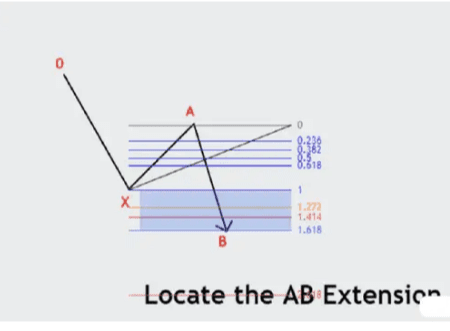
4. Draw the extension of the BC wave: measure the BC wave (the extension part of the AB wave), which usually ranges from 161.8% to 224% of the AB wave's retracement.
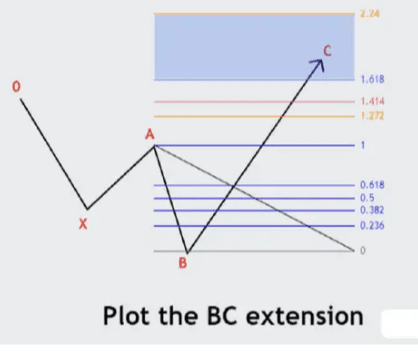
5. Verify the CD wave: finally confirm whether the CD wave has retraced about 50% of the BC wave. This step will confirm the completion of the 5-0 pattern and mark potential reversal points.
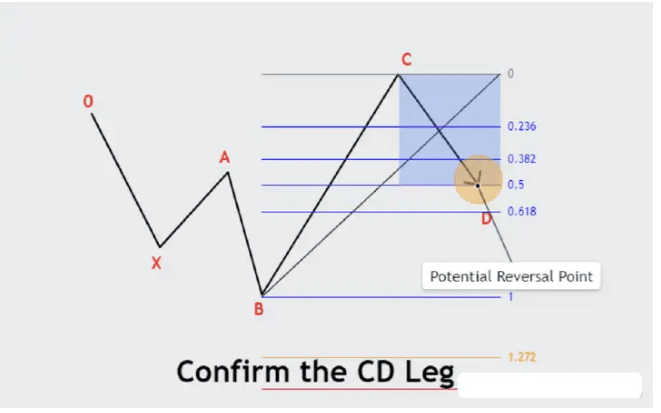
For traders who prefer automated solutions, charting platforms like TradingView, MetaTrader, and ThinkorSwim offer harmonic pattern recognition indicators. These tools can automatically detect and mark the 5-0 trading pattern on price charts, greatly simplifying the analysis process.
To use it, just enable the harmonic pattern tool, check the 5-0 trading pattern option in the settings, and the system will automatically scan for potential pattern structures.
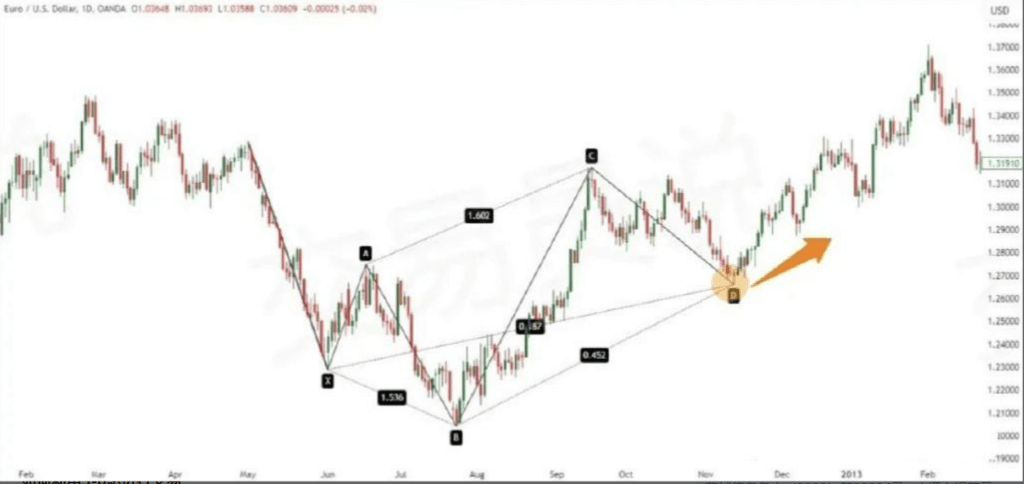
Automated tools are particularly advantageous for traders operating multiple varieties or multiple time frames, saving time and improving efficiency.
How to trade using the 5-0 pattern.
The key to trading the 5-0 pattern lies in identifying the completion of the DE segment and trading based on the expected reversal. Here are several steps to effectively trade this pattern:
1. Identify the pattern.
The first step in trading the 5-0 pattern is to identify it on the price chart. Traders can manually draw this pattern based on the aforementioned steps or use automatic harmonic pattern recognition indicators provided in trading platforms (if available) to assist in identification.
Remember, confirming the validity of the pattern is crucial; ensure all waves (XA, AB, BC, CD, and DE) comply with specific Fibonacci ratios. The accuracy of identification will significantly affect the reliability of the trade.
2. Wait for the pattern to complete.
Patience is key in trading the 5-0 pattern. Traders must wait for the DE segment to reach the expected Fibonacci retracement level before taking action.
The DE segment usually completes at the 50% retracement level of the BC segment. If you enter the market too early before the pattern fully forms, you may suffer unnecessary losses due to the price not reversing near the expected reversal point.
Monitoring price behavior near expected completion areas of the DE segment helps confirm the validity of the pattern and reduces the likelihood of false signals.
3. Determine entry points.
Once the DE segment is completed, it marks a potential reversal area. Traders should enter as close to this completion point as possible.
For bullish 5-0 patterns, the price is expected to reverse upwards, and traders can establish long positions.
Conversely, for the bearish 5-0 pattern, the price is expected to reverse downwards, hence short positions are recommended.
Combining other confirmation signals (such as candlestick patterns: hammer, engulfing patterns, etc., or momentum indicators: RSI, MACD, etc.) can further enhance the reliability of the trade.
4. Set stop-loss and target levels.
Risk management is crucial when trading the 5-0 pattern. To prevent unexpected price fluctuations or pattern failures, traders should set stop-loss points beyond the completion point of the DE segment.
For bullish patterns, the stop-loss should be set slightly below the DE point; for bearish patterns, it should be set slightly above the DE point. This stop-loss setting allows for natural development space in trading while minimizing potential losses as much as possible.
Setting profit target areas is also an important step in trading the 5-0 pattern. Appropriate target price levels can be judged using Fibonacci extension levels and previous key support/resistance levels.
Common targets include the 38.2%, 50%, or 61.8% Fibonacci extension levels of the DE segment. Traders can also choose to take profits in batches, reducing positions at multiple target levels to lock in profits, while allowing some positions to continue holding to capture more gains as prices move further in the expected direction.
Case Study
The structure of the 5-0 trading pattern is similar to the inverse head and shoulders pattern, where the second 'shoulder' is extended in time. In the following EUR/USD daily chart, we can draw a 5-0 pattern.
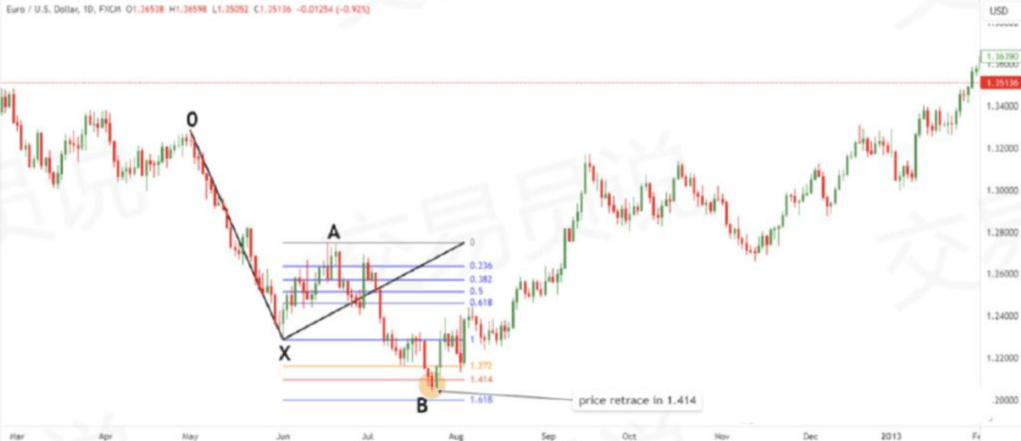
We drag the Fibonacci retracement tool from point X to point A. In this case, point B almost touches the 1.618 level, which aligns with the rules of this pattern—it must fall between 1.13 and 1.618.
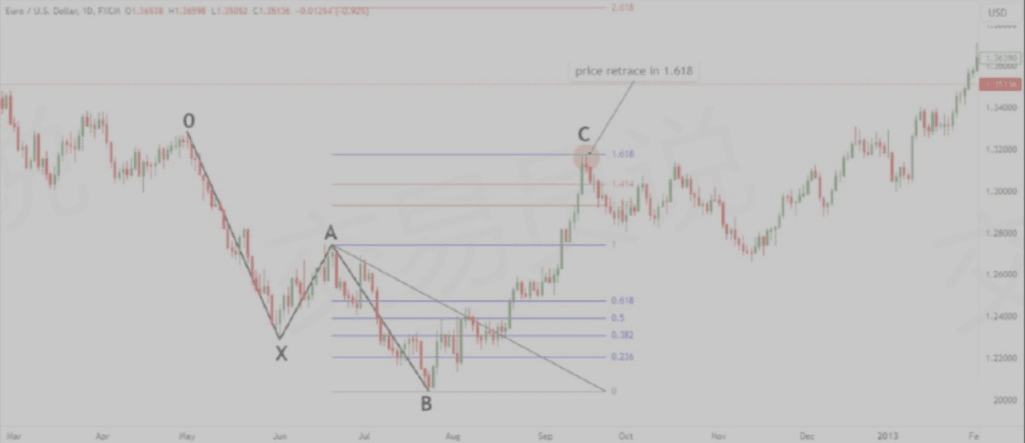
Next, reposition the Fibonacci tool from point A to point B. Point C should align with the 1.618 projection level of the AB segment. In this case, point C successfully meets this condition, so we can proceed to the next step.
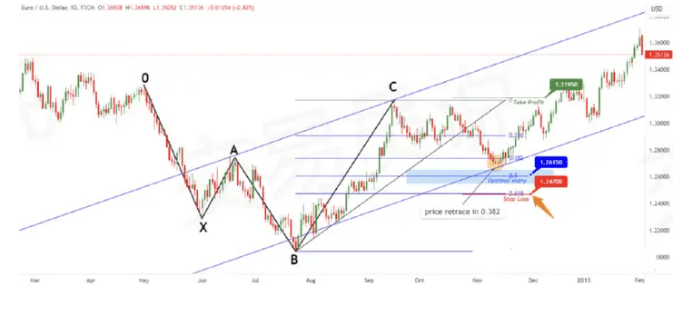
Now, move the Fibonacci tool from point B to point C to evaluate the trend of the DE segment. Pay attention to whether the price retraces to the 0.50 retracement level and begins to move upwards. This indicates that the DE segment may be forming and serves as a signal that the pattern is about to complete.
To further confirm, you can draw an upward channel. The first line connects point A and point C, while the second line connects point B. If the price remains within this channel, it will further enhance the validity of the pattern and act as an additional buy signal.
After confirming the pattern, formulate a trading plan... In this example, the best buying area is around 1.2615. The stop-loss should be set below the correction range, around 1.2470, which also corresponds to the 0.618 Fibonacci retracement level. To further confirm the entry signal, a descending trend line can be drawn, and trading should be executed after the price breaks through this trend line.
Finally, set profit targets to effectively manage trades. The first target can be set at 1.3110, aligned with the level of the XA segment; the second target is 1.3195, which is the previous high of this pattern.
Many people trade contracts, and when asked 'Are you using full position or partial position?', they look confused.
More seriously, some people don't even understand the difference between these two and directly open leverage, ending up getting liquidated without knowing how.
First, let's talk about position trading:
Partial position means that whatever amount you invest in this contract is the maximum you can lose.
For example, if you have 5000 USDT in your account, and only use 500 USDT for this trade, even if the market goes against you, you will at most only lose that 500 USDT, and not drag your entire account down.
Who is it suitable for? Suitable for those who want to control risk and prefer a steady approach.
You can treat each trade as an independent battle; you won't lose everything just because one trade goes wrong.
Let's talk about full positions:
Full position means if this trade blows up, the remaining money in your account goes down with it.
The system will use the remaining funds in your account to 'extend the life' of the current position until the entire account can no longer sustain it, at which point it will clear everything at once.
It sounds like it has a 'higher tolerance', but the risks are also greater.
Many people have the illusion of using full positions: 'I can hold on', but when big fluctuations occur, they end up losing everything. Especially for those who like to hold positions without setting stop-losses, a full position is almost a time bomb.
So how to choose?
If you are still familiarizing yourself with the market or just starting to try contracts, prioritize using partial positions as this is the most direct way to protect your capital.
Wait until you have your own trading system and can execute risk control stably before considering using full positions to increase efficiency—however, even then, you must set a stop-loss.
Ultimately, the essence of contracts is not to make quick money, but to allow you to hold on longer and move steadily.
Don't treat your account like a casino; if you don't even know where the risks come from, and dare to place heavy bets, that is not trading, but gambling with your life.
Full position and partial position are not about which is more advanced, but rather whether you have the ability to manage them.
In this round of market trends, whether you can turn around and recover depends entirely on yourself. Start laying out strategies with me early so you can get out of the lows sooner.
Playing around in the crypto world is essentially a contest between retail investors and market makers. If you don't have insider information or first-hand data, you can only be cut! If you want to collaborate in strategies and harvest the market maker's profits, feel free to reach out to me!
I only trade in real accounts; the team still has spots available if you want to join.


